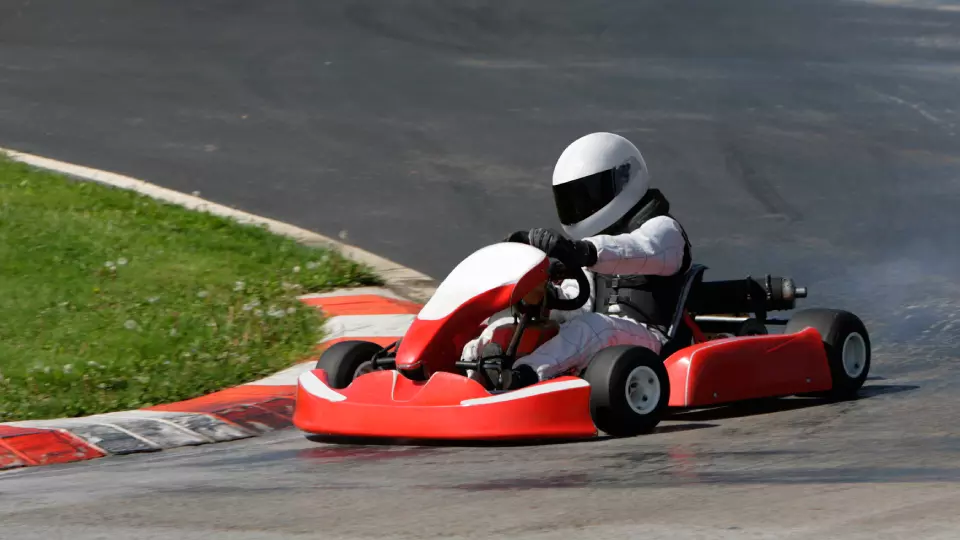Becoming a good go-kart racer requires talent, skill, and an understanding of technical and key concepts. These concepts include general karting tips, overtaking, and also cornering – similar to other types of motorsports.
While the basic principles of taking corners may seem easy, mastering the art of go-kart cornering requires a deeper understanding of various advanced techniques that I will be sharing with you in this guide.
If you’re a beginner, I suggest that you familiarize yourself with my guides on general go-kart racing tips and go-kart overtaking first, as I introduce more basic concepts there. With that out of the way, let’s dive into the 10 most important go-kart cornering tips and what mistakes to avoid!
1. Know When to Brake
When cornering, braking is among the most crucial things to learn. Knowing when to brake isn’t just important to shed speed during your approach, but it also sets up the rest of the corner, especially where you pick your line of entry.
Braking too late means you’ll be going too fast and may move past the corner’s apex. This may lead to a loss of control or even make you spin out. On the other hand, braking too early before a corner means you’ll lack speed, which could affect your lap times and ultimately your overall performance on the race track.
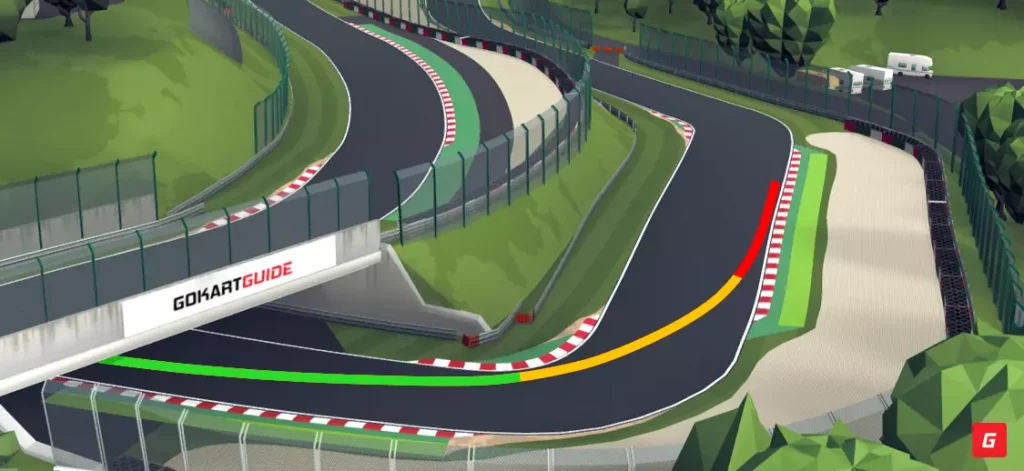
- Red: Braking
- Orange: Speed Reduction
- Green: Acceleration
If you’re only getting started with karting, consider estimating your brake point earlier, and lose the brake pedal slowly at the turn. This should slow you down enough to ensure that you don’t veer off the track.
It will take some time to get used to, but it’s always best to practice taking corners and timing brakes in your go-kart at slower speeds and gradually increase it the more experienced you get.
Apart from knowing the right braking point, understanding the different types of braking techniques will also help. Below are some techniques which are used by advanced racers, when taking corners.
- Cadence Braking: Cadence braking, also called stutter braking, is a braking technique often used when racing go-karts. It involves rapidly depressing and releasing the brake pedal in quick succession to slow down the kart without skidding or losing control. This type of braking can be useful in tight corners where a traditional braking method would cause the kart to skid or spin out. Cadence braking requires practice and skill to master, but can be a useful technique for more advanced go-kart drivers.
- Trail Braking: Trail braking is a braking technique used to improve cornering performance by timing and distributing the braking activity throughout the corner. This is achieved by applying about 3/4 of your braking potential shortly before you enter a corner, followed by about 1/4 as you increase the angle before you start to accelerate out of the turn again. This technique is often used by professional racers and is a great way to improve your own cornering performance. However, it is important to note that trail braking can be dangerous if not done correctly.
- Threshold Braking: One of the most important skills in go-karting is learning how to use the threshold brake. Threshold braking is when you brake hard enough so that the wheels are just on the verge of locking up. This requires a delicate balance, as you don’t want to lock up the wheels and lose control, but you also don’t want to brake too lightly and carry too much speed into the corner. One of the best ways to learn how to threshold brake is to practice on a skid pad or a large open area.
2. Follow the Racing Line
The racing line refers to the route followed by kart racers to complete a lap in the least possible time. It’s the path that is quickest around the track and will help you to get the most out of your go-kart and ultimately your performance.
Following it allows you to decrease your lap times, but it’s not as easy as it sounds. It takes a lot of master cornering by strictly following the racing line, as your timing, speed, and positioning need to be immaculate.
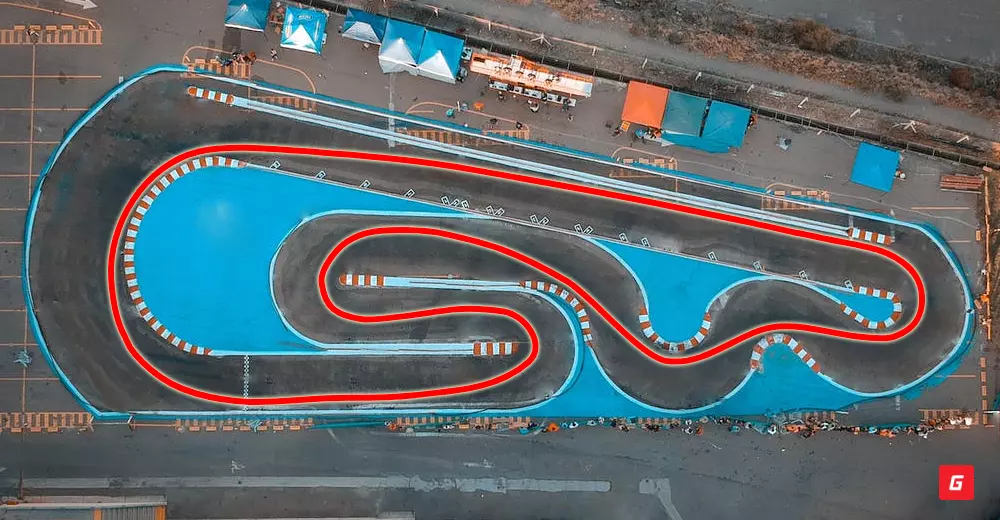
Practice your skills in the below areas to master the racing line:
- Braking points: you should brake before the turn, in order to slow down and then accelerate through the turn. Timing is key when approaching a corner – you’ll need to be at optimal speed.
- Corner Types: You’ll also need to understand the different types of corners of a go-kart track and when you should start turning your steering wheel. More information on that a little later.
- Speed: Practice the optimal turning speed – too fast and you will spin out, too slow and your performance will take a hit.
- Position: Every track has a racing line. You should always stick to the optimal racing line whenever possible. There are exceptions for wet track conditions and when overtaking other go-karts. In all other cases, following the racing line offers you the quickest path around the track (especially in corners).
3. Steer Steadily
When nearing a corner, avoid steering too early. Patience is key here. Increase the speed and turning rate gradually, while also ensuring that your movements remain smooth despite facing pressure.
This will not only prevent you from spinning out of the track but also let you reach the apex timely. Panicking and abrupt steering are one of the biggest mistakes racers make at this point.
Be in control over your steering wheel and guide your go-kart through the corner. This will take time and regular practice but the results will be meaningful.
4. Understand The Different Parts of Corners
If you really want to achieve perfection when it comes to go-kart cornering, you’ll need to obtain a profound understanding of the three parts of a corner. While different corners feature different names, shapes, and angles, they are often split into three separate parts, namely, the entry, apex, and exit.
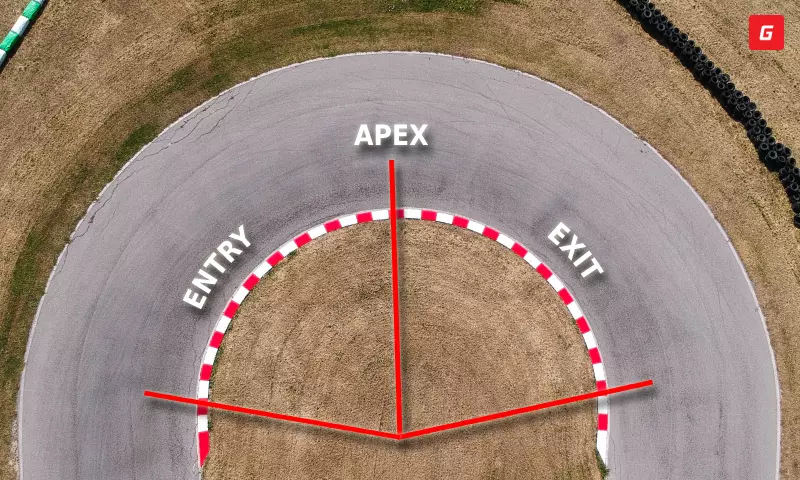
- The Entry: This is the turn-in point, where you should generally adopt a wide approach. It’s also important to apply the correct braking technique across the braking zone.
- The Apex: This refers to the mid-point or clipping point of a corner, and is itself categorized into the early apex, late apex, and mid apex. This is the area of a corner where you are required to have a good balance of throttle and brake control. It’s where you transition from braking into accelerating.
- The Exit: This area marks the end of the apex, where you start to fully accelerate as you head into the straight section. You’ll need to ensure that you straighten your front tires before exerting maximum throttle pressure. Failing to do so may cause your rear to swing out.
To achieve faster lap times and maximum speed on the straights, use the late apex on corners before a long straight. For corners where the straight that follows is shorter than the subsequent straight, the early apex proves great.
At the corner exit, if you seem to be losing the back end of the go-kart, you’ve applied too much throttle. To gain control, ease back on it at this point before accelerating.
5. Understand the Different Types of Corners
Improving your cornering skills also requires a clear understanding of the different types of corners you may come across, during a go-kart race. Not all corners are the same and each requires a slightly different approach while keeping in mind the same braking techniques.
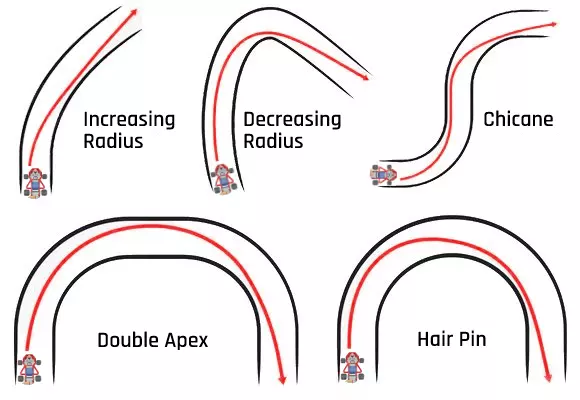
Here are the most common corner types found on kart tracks:
- Hair Pin Corner: A hairpin corner is very tight, with a radius that is much smaller than the rest of the track (typically equal to or more than 180 degrees). This type of corner requires extreme deceleration and grip strength.
- Double Apex Corner: A double apex turn is a type of corner that has two apexes or points at which the driver needs to turn. This corner is typically used to slow down drivers as they approach a straight section.
- Right Angle Corner: As the name suggests, a right angle corner has an angle of about 90 degrees. These types of corners are great for practicing different types of braking techniques.
- Increasing Radius Corner: An increasing radius turn is one where the radius of the turn increases as you progress through it. This type of corner is typically used when coming out of a tight turn and onto a straightaway.
- Decreasing Radius Corner: A decreasing radius turn is one where the radius of the turn decreases as you progress through it. This type of corner is typically used when approaching a tighter turn from a straight section.
- Chicane Corner: A chicane is a type of corner that is made up of two turns in quick succession, that go in alternate directions. This type of corner is typically used to slow down kart racers as they approach a new sector.
6. Control Your Speed
Another important thing to remember when cornering in your go-kart is to control your speed. You may be tempted to go full throttle around the bend, but this is a surefire way to lose control and veer off the track.
Instead, take your foot off the accelerator and proceed to brake, in order to slow down before you enter the turn. Failing to do so can lead to spin-outs, accidentally drifting, and even overshooting it. Then, accelerate as you exit the turn and into the next section of the track.
7. Be Aware of Other Go-Karts
Remember that you’re not the only one on the race track. You should be aware of other go-karts at all times and give them plenty of space. While go-kart racing is competitive motorsport, it’s important to understand that you’ll need to let faster drivers pass.
If someone is tailgating you aggressively and you aren’t able to defend your position, let them pass you. On the other hand, if you’re overtaking someone, make sure you do it safely and only when it’s clear.
Safety is the most important aspect of racing, especially when it comes to karting. Feel free to read interesting statistics and information on go-kart safety.
8. Consider the Track Conditions
The condition of the track can have a big impact on your cornering. If it’s raining, your tires will make less contact with the surface and you can easily lose grip. You’ll also need to be more cautious when cornering, requiring you to brake earlier and also reduce your speed so that your go-kart won’t spin out.
In dry conditions, you’ll be able to push your go-kart harder around corners and can even take a more aggressive racing line. Therefore, be sure to take the weather and track conditions into account when you’re racing.
9. Plan Ahead
One of the best ways to improve your cornering is to practice. Get out on the track and take some time to get a feel for how your go-kart handles around corners. When you’re driving, think ahead about how you’re going to approach the next turn.
This will help you stay focused and make better decisions. This is particularly important if you’re not too familiar with the race track. As the saying goes, practice makes perfect.
10. Keep Both Hands on the Steering Wheel
This may seem like a no-brainer, but it’s important to keep both hands on the steering wheel when you’re cornering in a go-kart. This may be different from when you’re driving a car, but while racing go-karts, you should have both of your hands firmly on the steering wheel at all times.
This will give you more control over the go-kart and help you stay on course. The only exception is when you’re operating a shifter kart. Even then, you should place your gear-shifting hand back onto the steering whenever possible.
Important Things to Avoid While Cornering
While the guide above is designed to show you crucial tips and techniques when it comes to go-kart cornering, it’s also important to share some of the important things that you should avoid at all times. Let’s take a closer look below!
Don’t Drive Recklessly
One of the most important things to avoid when cornering is reckless driving. This means going too fast, not paying attention to what is ahead, and generally not being in control of your go-kart.
Don’t Over or Understeer
Another important thing to avoid when cornering is oversteering or understeering. Oversteering is when the back end of the go-kart starts to slide out, and understeering is when the front end of the go-kart pushes wide. Both of these can be dangerous and cause you to crash.
Don’t Lose Focus
It is important to stay focused when cornering in a go-kart because any distraction can cause you to lose control. This means that you should keep your eyes on the track and not let anything distract you. Remember to stay hydrated before and during your race and make sure that you get enough rest.
